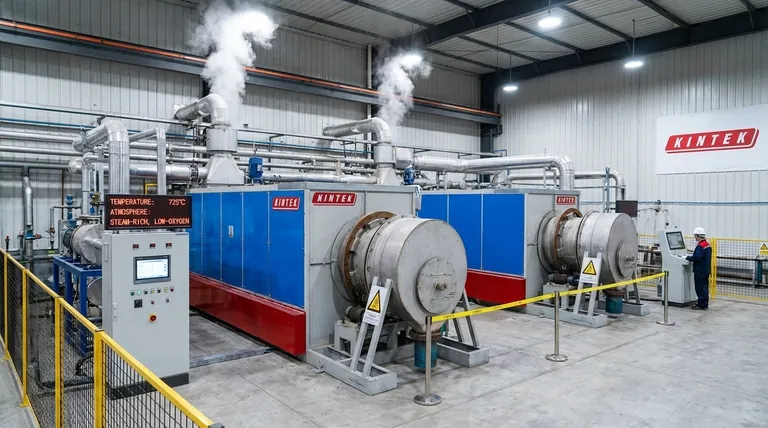To effectively regenerate activated carbon, a kiln must operate within a precise temperature range of 650°C to 800°C (approximately 1200°F to 1475°F). This specific heat is critical for breaking down the adsorbed contaminants that have saturated the carbon, a process that must be conducted in a carefully controlled, low-oxygen atmosphere to avoid destroying the carbon itself.
The success of carbon regeneration hinges on a delicate balance: applying enough heat to vaporize contaminants while using a steam-rich, low-oxygen atmosphere to prevent the carbon from combusting and being destroyed.

The Science of Thermal Regeneration
Understanding why the specific temperature range is so critical requires looking at the overall process. The goal is not just to heat the carbon, but to create an environment where impurities are removed and the carbon’s valuable structure is preserved.
The Role of High Temperature
The primary function of the heat is to provide the energy needed to break the physical and chemical bonds between the carbon surface and the adsorbed organic contaminants. This process is known as volatilization, turning the impurities into a gas so they can be carried away.
Creating a Controlled Atmosphere
Simply heating carbon in the presence of air would cause it to burn away. To prevent this, regeneration kilns use a steam-rich, oxygen-deprived atmosphere. The steam acts as an oxidizing agent that selectively attacks the contaminants, while the lack of oxygen prevents the carbon itself from combusting.
The Importance of Agitation
The carbon must be exposed uniformly to these conditions. This is why kilns are typically rotating tubes. The slow rotation gently tumbles, or agitates, the carbon granules, ensuring that every particle reaches the target temperature and comes into contact with the steam.
Understanding the Critical Temperature Window
Operating outside the optimal 650°C to 800°C range directly compromises the efficiency and cost-effectiveness of the regeneration process.
Below 650°C: Incomplete Regeneration
If the temperature is too low, the energy supplied is insufficient to break down all the adsorbed contaminants. This results in partially cleaned carbon with significantly reduced performance and a shorter operational life before it needs to be regenerated again.
Above 800°C: Carbon Degradation
If the temperature is too high, the heat begins to damage the intricate internal pore structure of the activated carbon. This process, known as sintering, reduces the surface area available for future adsorption, permanently diminishing the carbon's capacity and effectiveness.
Key Factors and Trade-offs
Achieving optimal regeneration involves managing several competing factors. Misunderstanding these can lead to carbon loss and poor performance.
Oxygen Contamination: The Primary Risk
The single greatest risk in thermal regeneration is the presence of excess oxygen inside the kiln. Oxygen will cause the carbon to combust, leading to direct product loss. This is why maintaining a positive pressure with steam is critical to keep air out.
Residence Time
Temperature is not the only variable; residence time—how long the carbon spends in the hot zone—is also crucial. A typical residence time is around 20 minutes to ensure complete contaminant breakdown without excessive heat exposure.
Type of Contaminant
Different organic compounds vaporize at different temperatures. While the 650°C to 800°C range covers most common applications, heavily entrenched or complex contaminants may require operating at the higher end of this scale.
Optimizing Your Regeneration Process
Achieving consistent results requires aligning your kiln's parameters with your operational goals. Use these points as a guide for setting your target temperature.
- If your primary focus is maximizing carbon lifespan: Operate at the lower end of the temperature range (650°C - 725°C) to minimize structural damage to the carbon over many cycles.
- If your primary focus is removing stubborn contaminants: You may need to operate towards the higher end (725°C - 800°C), but you must carefully monitor for carbon loss due to oxidation.
- If you are experiencing high carbon loss: Before increasing temperature, verify that your kiln atmosphere is properly sealed and oxygen-deprived, as unwanted combustion is the most common cause of loss.
Ultimately, mastering carbon regeneration is about the precise control of both temperature and atmosphere to restore performance without destroying the asset.
Summary Table:
| Factor | Optimal Range / Condition | Consequence of Deviation |
|---|---|---|
| Temperature | 650°C - 800°C (1200°F - 1475°F) | Below: Incomplete cleaning. Above: Carbon degradation (sintering). |
| Atmosphere | Steam-rich, low-oxygen | Oxygen contamination causes carbon combustion and loss. |
| Residence Time | ~20 minutes | Too short: Incomplete regeneration. Too long: Unnecessary heat exposure. |
Optimize your carbon regeneration process and extend the life of your valuable activated carbon assets. KINTEK specializes in providing robust, precisely controlled thermal processing solutions for laboratory and industrial applications. Contact our experts today to discuss how our equipment can enhance your operational efficiency and cost-effectiveness.
Visual Guide

Related Products
- Electric Rotary Kiln Small Rotary Furnace for Activated Carbon Regeneration
- Vacuum Sealed Continuous Working Rotary Tube Furnace Rotating Tube Furnace
- Laboratory Vacuum Tilt Rotary Tube Furnace Rotating Tube Furnace
- Laboratory Quartz Tube Furnace Tubular RTP Heating Furnace
- Vertical Laboratory Quartz Tube Furnace Tubular Furnace
People Also Ask
- What is the temperature for activated carbon regeneration? Key Ranges from 220°C to 900°C
- How to regenerate activated carbon? Master the 3-Stage Thermal Process for Cost Savings
- What are the principles of a rotary kiln? Master the Mechanics of High-Temperature Processing
- What is the temperature of a carbon regeneration kiln? Mastering the 750-800°C Reactivation Process
- How is energy converted into biomass? Harnessing Nature's Solar Power for Renewable Energy



















